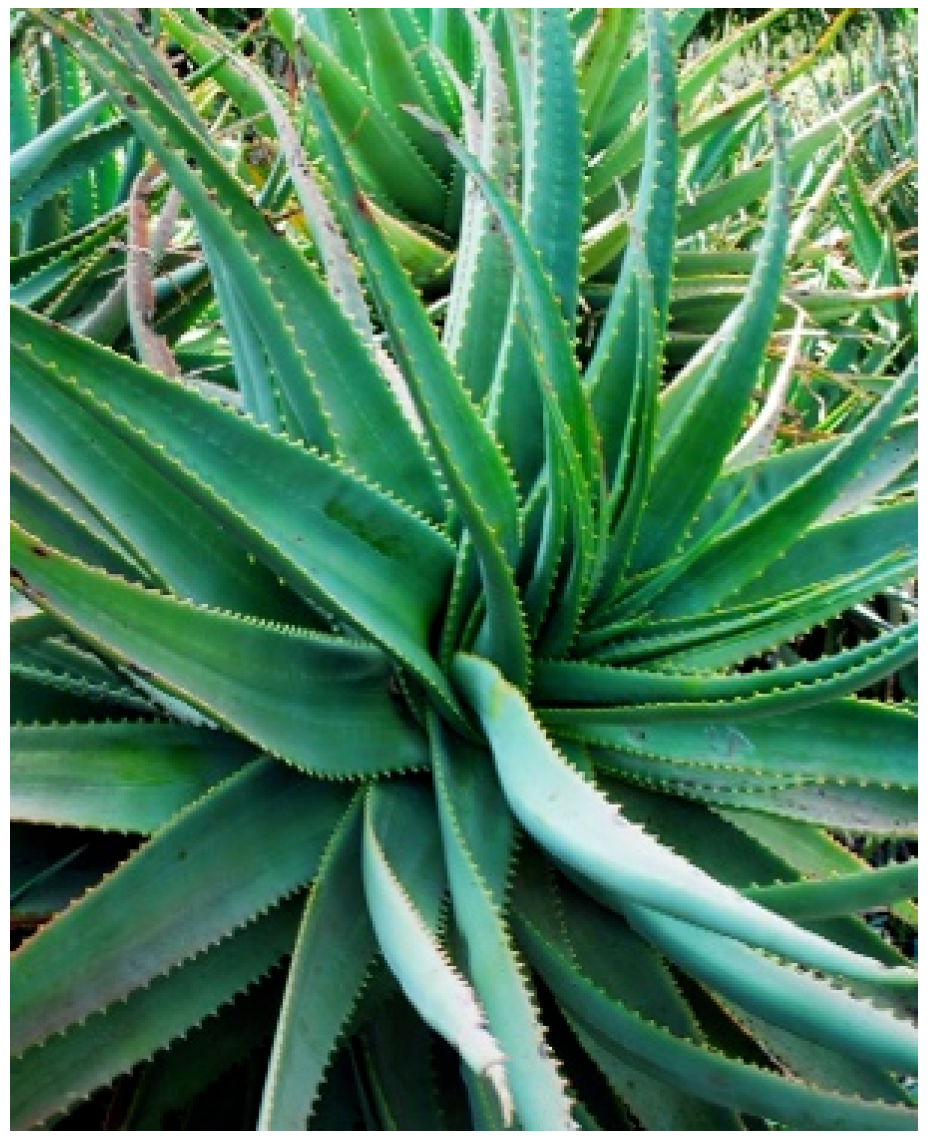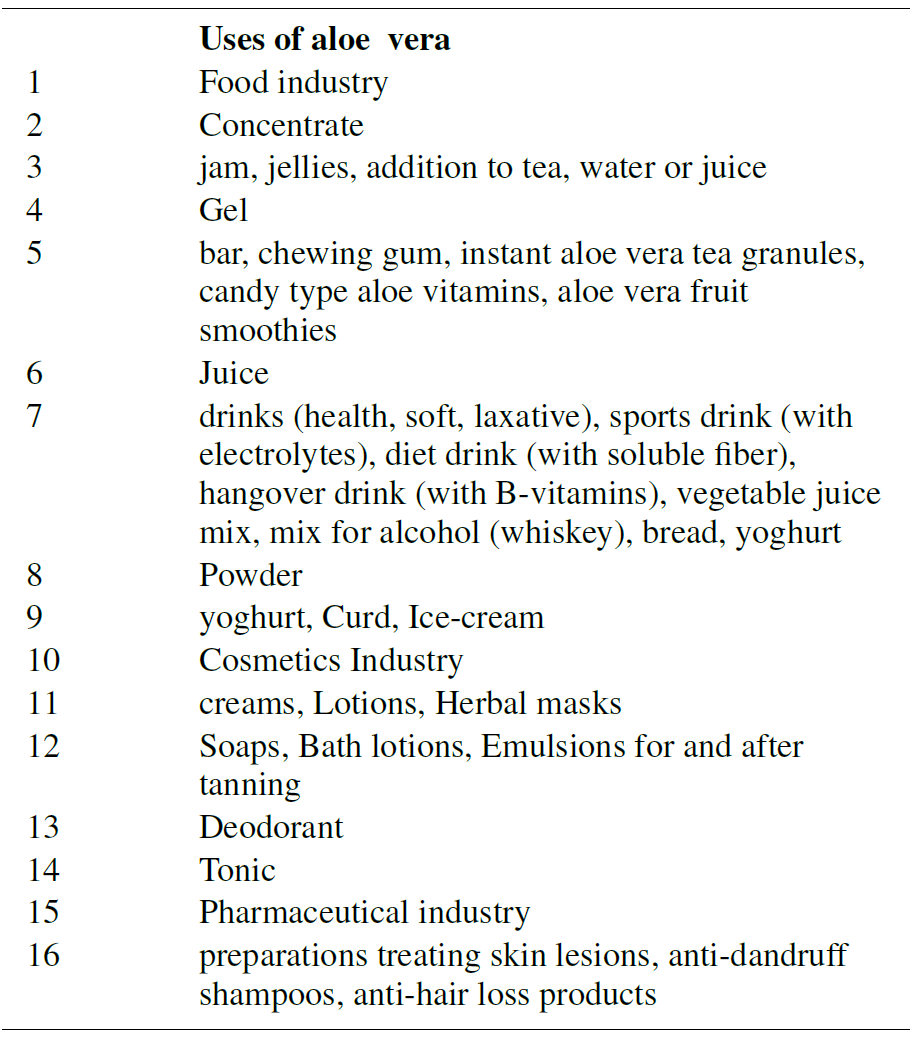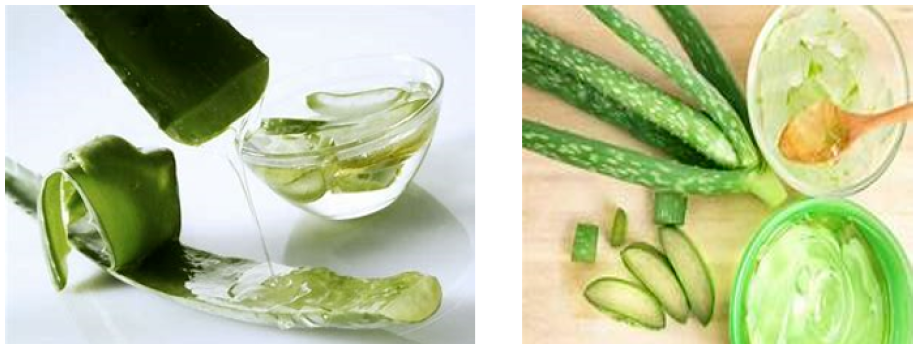Full HTML
Role of aloe vera in skincare: exploring its therapeutic benefits, formulations, and future innovations
Shatrughna U. Nagrik1*, Shivshankar M1, Vishal S. Chharre1, Shubhangi M. Dhage1, Vrushali S. Borey1
Author Affiliation
1Department of Pharmacology, Satyajeet College of Pharmacy, Mehkar, Maharashtra, India
Abstract
One of the most ancient species of the Asphodelaceae family, Aloe barbadensis, known for its medicinal, cosmetic, and therapeutic properties, has been used for thousands of years. The Egyptians called it the "plant of immortality," and the use of this plant in skin care dates back thousands of years to ancient Greece and China, where it had a high esteem for its healing and soothing properties. In the modern world, Aloe vera has become an indispensable ingredient in topical dermatological preparations because of its great variety of bioactive compounds, including vitamins, enzymes, polysaccharides, and amino acids, which help confer to it hydrating, anti-inflammatory, and antimicrobial properties. This study focuses on investigating the role played by Aloe vera in skincare by considering its biochemical composition, action mechanisms, clinical uses, and safety evaluations. The bioactive compounds of Aloe vera, including polysaccharides and vitamins, synergistically hydrate, reduce inflammation, and facilitate wound healing. These characteristics contribute to the importance of the application of its use in products against many conditions: acne, eczema, psoriasis, and aging skin. Carrying out a critical evaluation of its therapeutic activity, this work deals with the multi-purpose uses of Aloe vera in commercial cosmetics such as sunscreens, after-sun care products, and sensitive skin preparations. This study juxtaposes unadulterated Aloe vera extracts with commercially formulated products, emphasizing their respective efficacies and constraints. Furthermore, the investigation assesses clinical research that substantiates the therapeutic benefits of Aloe vera in managing burn injuries, hydrating the skin, and soothing irritation. The research also tackles the obstacles encountered in the formulation of Aloe vera-infused products, including concerns regarding stability and interactions with other cosmetic components. The project emphasizes the need for quality control and standardization as well as regulatory consideration that ensures safety and efficacy in long-term usage of Aloe vera. Additionally, the prevailing consumer trends that prioritize natural, vegan, and cruelty-free products are examined, highlighting the increasing prominence of Aloe vera within the skincare sector. The project culminates in a discussion of prospective developments, accentuating advancements such as nanotechnology, genetic engineering, and sustainable farming practices that may significantly augment Aloe vera's application in dermatology, especially in relation to anti-aging and skin barrier repair therapies.
DOI: 10.18231/j.yjom.2024.021
Keywords: loe Vera, Aloe barbadensis, Skincare benefits, Moisturizing effects, Clinical applications
Pages: 197-206
View: 35
Download: 38
DOI URL: https://doi.org/10.18231/j.yjom.2024.021
Publish Date: 15-12-2024
Full Text
Aloe vera (Aloe barbadensis) is a well-known medicinal plant belonging to the family Asphodelaceae. It has been used for centuries across various civilizations for its therapeutic, cosmetic, and medicinal benefits. Historically, the Egyptians referred to Aloe vera as the “plant of immortality” and used it in their beauty treatments. Its use in skincare can be traced back to ancient Greece and China, where it was applied to treat wounds and skin irritations. Today, Aloe vera is extensively incorporated into modern skincare products due to its beneficial properties. 1 It was introduced to the northern regions as well as to other countries around the world. Commercial cultivation of plant includes Aruba, Bonaire, Haiti, India, South Africa, the United States and Venezuela. However, the best quality aloe vera plant comes from the desert of southern California. Several names of this plant are known i.e. Aloe, Aloe vera, Aloe capensis. Aloe spicata, Barbados loe, Cape aloe; the names are various and depend also on the country of cultivation or origin e.g. Chirukattali (India), Laloi (Haiti), Lohoi (Vietnam), Luhui (China), Rokai (Japan), Sabilla (Cuba). 2 Aloe vera (Figure 1 ) is a succulent plant renowned for its medicinal properties. Its thick, fleshy leaves contain a gel rich in vitamins, minerals, and amino acids.

Figure 1: Aloevera Plant
The use of aloe vera is very wide by the industry, in particular by such branches as food and cosmetics.( Table 1) The use of aloe vera is very wide by the industry, in particular by such branches as as food and cosmetics.
Table 1. Use of Aloe

Botanical classification
Aloe barbadensis is part of the Liliaceae family, although it is often placed in the Asphodelaceae family in modern classifications.
Brief history of use
The history of Aloe vera spans over 6000 years. In Egyptian records, it was depicted in stone carvings as a sacred plant with healing powers. Over time, Aloe vera gained widespread use in skincare and cosmetic industries due to its moisturizing, anti-inflammatory, and healing properties.
Skincare benefits
Aloe vera contains vitamins, enzymes, minerals, amino acids, and polysaccharides responsible for its moisturizing, soothing, and repairing action on skin. 3 The image of Aloe vera juice (Figure 2) showcases its vibrant color and inviting appearance, making it an appealing choice for health-conscious consumers.

Figure 2. Aloe vera juice
Importance of aloe vera in traditional and modern skincare
Aloe vera is classified as a succulent that has formed the backbone in traditional remedy for thousands of years, mainly in the skincare field. The popularity of this succulent is very much based on curative, soothing, and moistening properties that it has as a consequence of vitamins, enzymes, minerals, and amino acids. In modern terms, Aloe vera has evolved from merely being a traditional remedy into one widely studied and applied in many cosmetic products aimed at improving skin conditions. Aloe vera has been used in treating skin wounds, burns, and other dermatological conditions for a long time. It was applied on the skin as an extract from its leaves to cool down the skin and heal it. Its use can be traced back to the ancient civilizations of the Egyptians and Greeks, who knew about the healing properties of the plant. This makes it one of the widely used components in modern skincare practices because of its various advantages. It is basically a basic ingredient in lots of moisturizing formulations, sun protection products, and anti-aging treatments. The bioactive constituents of the plant, including polysaccharides, anthraquinones, and lectins, play a great role in its efficacy for skin hydration, facilitating recovery of
wounds, relieving inflammation, and overcoming microbial infections. Properties like these make it a necessary ingredient in routine skincare regimens and also in targeted therapeutic formulations.4
Composition of Aloe Vera
Key bioactive components
Aloe vera is renowned for its skin-soothing and healing properties, which stem from its rich composition of bioactive compounds. The major constituents of Aloe vera include vitamins, minerals, enzymes, polysaccharides, and amino acids. These compounds work synergistically to provide multiple benefits in skin care products.5
Vitamins
Aloe vera contains several key vitamins that contribute to skin health. Vitamin A (beta-carotene) aids in skin repair, while vitamins C and E act as antioxidants, protecting the skin from oxidative stress and environmental damage.
Vitamin C is also involved in collagen synthesis, promoting skin elasticity and reducing signs of aging.6
Minerals
Essential minerals in Aloe vera, such as calcium, magnesium, zinc, and copper, play vital roles in skin repair and regeneration. For example, zinc contributes to wound healing and has anti-inflammatory properties, making Aloe vera effective in managing skin irritation and acne.
Enzymes
Aloe vera contains enzymes like bradykinase, which reduces inflammation, and aloin, which acts as a mild exfoliant by removing dead skin cells. These enzymes enhance the penetration of other active ingredients in skin care formulations, making them more effective.
Polysaccharides
Among the most significant bioactive components, polysaccharides such as acemannan are known for their hydrating and skin-soothing properties. They form a protective barrier on the skin, helping to retain moisture and support the skin’s natural healing process.7
Amino Acids
There are several types of essential and non-essential amino acids that Aloe vera provides, which are essential in the nourishment and restoration of skin. It especially has glutamic acid and serine, which are important for
moisturizing and reviving the skin. The presence of amino acids makes Aloe vera a very valuable ingredient in hydrating and repairing products. The bioactive compounds present in Aloe vera, such as vitamins, minerals, enzymes, polysaccharides, and amino acids, determine its multi-dimension application in skin care. These factors hydrate the skin, reduce inflammation, promote wound healing, and protect the skin against environmental aggressors, making Aloe vera an exclusive part of modern skin care components.
Overview of the therapeutic properties of these components
The diversified mixture of constituents found in aloe vera gives them a number of therapeutic benefits. It has commonly been recognized for its anti-inflammatory, antimicrobial, and wound-healing properties, thereby making it an important ingredient in skincare.
Anti-Inflammatory activity
Aloe vera inhibits enzymes such as cyclooxygenaseresponsible for inflammation; thus, it tends to reduce inflammation. This makes it very useful in treating skin diseases such as acne, psoriasis, and eczema.8
References
1. Sharma P, Kharkwal AC, Kharkwal H. A review on pharmacological properties of Aloe vera. Int J Pharm Sci Rev Res. 2014;29(2):31–7.
2. Miko N. Potential health benefits of aloe vera Natalia Mikołajczak. J Educ Heal Sport. 2018;8(9):1420–55.
3. Mikołajczak N. Potential health benefits of Aloe vera; 2018. Available from: https://www.medicalnewstoday.com/articles/265800.
4. Surjushe A, Vasani R, Saple DG. Aloe vera: A short review. Indian J Dermatol. 2008;53(4):163–6.
5. Hamman JH. Composition and Applications of Aloe vera Leaf Gel.
Molecules. 2008;13(8):1599–616.
6. Danhof IE, Mcanally BH. Aloes: The genus Aloe. London: CRC Press; 2002. p. 43–67.
7. Reynolds T, Dweck AC. Aloe vera leaf gel: A review update. J Ethnopharm. 2003;86(1):3–7.
8. Mukherjee PK, Nema NK, Maity N. Phytochemical and therapeutic profile of Aloe vera. J Nat Remedies. 2014;14(1):1–26.
9. Moghaddasi MS, Res M. Aloe Vera: Its chemical composition and applications: A review. Int J Biol Med Res. 2011;2(1):466–71.
10. Dey P, Dutta S, Chowdhury A, Das AP. Variation in phytochemical composition reveals distinct divergence of Aloe vera (L.) Burm.
F. from other Aloe species. J Evid Based Comp Alternat Med. 2017;22(4):624–31.
11. Kumar S, Yadav M, Yadav JP. Impact of spatial and climatic conditions on phytochemical diversity and in vitro antioxidant activity of Indian Aloe vera (L.) Burm. f. S Afr J Bot. 2017;111:50–9.
12. Singh S, Anjum S, Joy J, Gupta B. Polysaccharide-aloe vera bioactive hydrogels as wound care system. . Cellulose-Based Superabsorbent Hydrog. 2019;p. 1473–90.
13. Maan AA, Nazir A, Khan MK, Ahmad T, Zia R, Murid M, et al. The therapeutic properties and applications of Aloe vera: A review. J Herb Med. 2018;12:1–10.
14. Mohiuddin AK. Skin Care Creams: Formulation and Use. Dermatol Clin Res. 2019;1:103.
15. Napagoda M, Witharana S. Exploring the Plant Kingdom for Sources of Skincare Cosmeceuticals: From Indigenous Knowledge to the Nanotechnology Era. . In: and others, editor. Wild Planet; 2020. p. 18.
16. Saleem A, Naureen I, Naeem M, Murad HS. Aloe Vera Gel in Skin and Pharmacological Properties. Int J Pharm Appl. 2022;5(1):1–8.
17. Burusapat C, Supawan M, Pruksapong C. Topical Aloe Vera Gel for Accelerated Wound Healing of Split-Thickness Skin Graft Donor Sites: A Double-Blind, Randomized, Controlled Trial and Systematic Review. . Plastis Reconst Surg. 2018;142(1):217–26.
18. Waller TA, Pelley RP, Strickland FM. Industrial processing and quality control of Aloe barbadensis (Aloe vera) gel. Aloes. 2004;p. 277–89.
19. Beringhs A, Rosa JM, Stulzer HK, Budal RM. Green clay and aloe vera peel-off facial masks: response surface methodology applied to the formulation design. Aaps Pharmscitech. 2013;14(3):1030–40.
20. Maan AA, Nazir A, Khan M. Therapeutic Properties and Applications of Aloe Vera: A Review. J Herbal Med. 2018;12:1–10.
21. Sibhat G, Kahsay G, Schepdael V. Evaluation of aloins, pH and moisture in Aloe leaf gel-based personal care products. Int J Cosm Sci. 2022;44(1):74–81.
22. Waller TA, Pelley RP, Strickland FM. Industrial processing and quality control of Aloe barbadensis (Aloe vera) gel. 1st ed. and others, editor. CRC Press; 2004. p. 68.
23. Sánchez-Machado DI, López-Cervantes J. Ancient knowledge with new frontiers. Trends Food Sci Technol. 2017;61:94–102.
24. Datta HS, Paramesh R. Trends in aging and skin care: Ayurvedic concepts. J Ayurveda Integrat Med. 2010;1(2):110–3.
25. Golmohammadi F. Medical plant of Aloe Vera in desert regions of Iran: greenhouses, economic importance, development, extension, processing and marketing. Black Sea JAgricul. 2022;5(2):45–53.
26. Smith AB, Vera JA. The Natural Ingredient for Skin Care. J Dermatol Res. 2022;34(2):123–35.
27. Yang F. Future Trends in Natural Skincare: Aloe Vera in the Spotlight. J Green Skincare. 2023;10(1):80–90.
28. Kumar S, Verma P. Synergistic effects of Aloe Vera with other active ingredients for skin care. J Cosmet Sci. 2021;72(1):71–85.
29. Patel R, Mehta R. Personalized Aloe Vera-based formulations for targeted dermatology. Pharm Res. 2021;38(7):991–1001.
30. Balaji A, Vellayappan MV, John AA. Biomaterials based nano- applications of Aloe vera and its perspective: a review. Royal Soc Chem Adv. 2015;5(105):86199–213.
